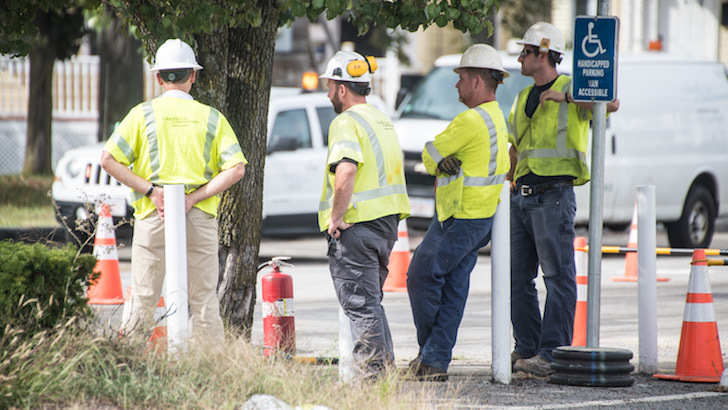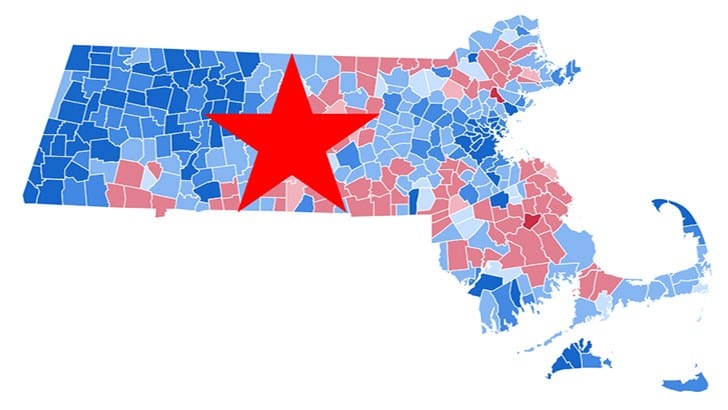
September 18, 2018
BY JASON PRAMAS @JASONPRAMAS
The events of last week in the Merrimack Valley were unfortunate by any measure. Something bad happened to the natural gas distribution system in parts of Lawrence, North Andover, and Andover that resulted in dozens of homes being damaged or destroyed by explosions and fire, at least 25 people getting injured, and one person (tragically, an 18-year-old) getting killed. The leading theory for the conflagration is that it was triggered by a pressure spike in area gas pipes. But until the National Transportation and Safety Board concludes its investigation—which could take up to two years—we likely won’t know the cause of that spike. According to ThinkProgress, the Mass Department of Public Utilities will be conducting its own investigation, and Attorney General Maura Healey will oversee that effort to ensure transparency.
The company responsible, Columbia Gas of Massachusetts—a division of NiSource Inc. of Indiana—was so slow to respond to the crisis that Gov. Charlie Baker put Eversource Energy in charge of the cleanup effort.
But the magnitude of the disaster is just starting to sink in. About 8,500 homes were affected, and its occupants are being told that it will take months to replace the cast iron gas pipes under city streets and restore service. Pipes so old, and so prone to rusting, leaking, and failure, that the federal Pipeline and Hazardous Materials Safety Administration started pushing gas utilities nationwide to replace them over a decade ago, according to USA Today. Yet despite being allowed to recoup such costs—which run about $1 million a mile—from their customers, utilities like Columbia have been slow to complete the needed work. Meanwhile, the thousands of residents that officials have allowed to return to their homes are forced to stay in apartments and houses that use gas for heating and cooking… with the gas shut off for the foreseeable future. As winter approaches.
This highlights the danger of using methane, an obviously flammable and explosive gas, as a fuel source for homes and businesses. Notwithstanding being in continuous use at millions of sites in the United States for well over 150 years, “natural” gas is not as safe as many people believe. According to the New York Times, “Since 1998, at least 646 serious gas distribution episodes have occurred across the country, causing 221 deaths and leaving nearly a thousand people injured. …” And the reasons for such episodes are not always found.
Perhaps it could not be otherwise, since America has allowed private companies to control the production and distribution of natural gas from the industry’s beginnings. Sure, we call those companies “public utilities” and tell ourselves that federal and state government regulate them. But, like all corporations answering to the siren call of the market, gas companies exist to make profits for their shareholders. To the exclusion of all other considerations—be they health, safety, environmental, or economic. Even though the small local gas companies of the 1800s have long since merged to become large and powerful combines, and even though they are allowed to be monopolies in the areas they control, they continue trying to save money on costs and make as much profit as regulators allow. Often quite a lot, since the phenomenon of “regulatory capture”—where a revolving door sending top staff back and forth between utilities and regulatory agencies generally assures that utilities have fat bottom lines—continues unabated. Including here in the Bay State. Whether utilities provide good service or bad.
Which is why National Grid—another one of the seven companies that have gas monopolies in parts of Massachusetts—is getting away with locking out 1,200 union gas workers who are trying to get a better contract for the difficult and dangerous work they do day in and day out. And why Columbia, which has already been dinged for recent safety issues in the regions of the Commonwealth gas infrastructure under its control, according to the Boston Globe, was allowed to continue business as usual until the Merrimack Valley fires brought international attention to the consequences of its malfeasance. Leading WGBH’s Jim Braude to wonder aloud on the Sept 17 episode of Greater Boston what would have happened if the gas network in Lawrence, North Andover, and Andover had been owned by National Grid. A company currently trying to service its infrastructure with ill-trained scab labor—some of them managers with little or no field experience. The better to bust the labor unions that protect the livelihoods of its workers, and permanently replace them with un-unionized workers that will make its stockholders even bigger profits.
If all these developments were taking place in a period where there were no demonstrable environmental consequences for burning fossil fuels like natural gas, they would be dire enough. But, unfortunately, that is not the case. True, burning methane as an energy source only produces about half as much carbon dioxide as burning coal, according to the Union of Concerned Scientists. However, there are so many methane leaks in the production and distribution of both oil and gas that any relative advantage to the environment that burning it provides is mostly erased, according to a Washington Post article on a key study in the journal Science. Given that methane is a much stronger greenhouse gas than carbon dioxide. So even the 2.3 percent of methane estimated to be leaking away into the atmosphere before it can be burned is enough to ruin its oft-hyped potential as a more “green” fossil fuel source that can be leaned on for decades while carbon neutral energy sources like solar are brought online on an industrial scale. Not because we don’t have the technology to do so faster, but because energy multinationals don’t want clean energy systems deployed until they’ve made all the money they can make by burning carbon.
Worse still, more than half of the natural gas being used in the Greater Boston area is now coming from fracked gas, according to Boston University earth and environment professor Nathan Phillips in a BU Today article. Fracking (more correctly, hydraulic fracturing) is an incredibly destructive and ecologically disastrous method of squeezing oil and natural gas out of vast underground shelves of shale rock by injecting massive amounts of water and any number of often-toxic liquid chemicals into them. Direct environmental impacts include ground, water, air, and noise pollution in those areas unfortunate enough to have lots of shale. And the technique has even been known to trigger earthquakes. Phillips also explains that fracked methane contains many impurities that may be making consumers sick. But the indirect impacts are far more problematic because fracked gas and oil have flooded the planet’s fossil fuel markets with cheap product at exactly the time we need to move away from burning carbon.
In a better world, the Merrimack Valley disaster would be a clarion call to move more decisively toward clean energy alternatives—at least in the affected communities as a useful demonstration project. In advance of doing so swiftly across the country, and in every corner of the globe. But we are not in that world. We’re in a world where energy corporations control the politics of the US and many other countries to their own advantage. And they want to ensure that humanity squeezes every last possible joule of energy out of fossil fuels like natural gas before allowing alternatives to finally become the dominant mode of energy production. Regardless of the fact that doing so will very likely result in a planet that’s unable to sustain advanced human civilization, and perhaps unable to sustain human life at all. If the worst global warming scenarios are allowed to become reality.
That’s why I have repeatedly called—most recently in a column about Eversource, the utility called upon to “fix” the Merrimack Valley crisis—for bringing energy companies to heel on both the environmental and economic fronts by winning the huge political struggles necessary to make them all genuinely public utilities. With a mission to provide cheap, clean, green energy like advanced wind, solar, and hydroelectric (ideally not from environmentally destructive mega-dams) power to America, and phase out all fossil fuel production, distribution, and usage as soon as possible. If we could accomplish that sea change in our energy system, other countries would be likely to follow at speed. And we might actually stand a chance of minimizing the damage from global warming, already on display with increasingly alarming frequency in the form of catastrophic storms like Hurricane Florence and Typhoon Mangkhut.
So if you want to help the Merrimack Valley disaster victims, certainly donate to the best local charities you can find. But also join environmental groups like Mass Sierra Club, Resist the Pipeline, and HEET (Home Energy Efficiency Team) that are working to end the ability of privately owned energy utilities to harm communities like Lawrence in particular and our planet’s ecosphere in general going forward. Furthermore, be sure to make your house, condo, or apartment as energy efficient you can and do whatever you can do to convert your dwelling from reliance on burning fossil fuel to using genuinely clean energy sources. Every little improvement helps. Just remember, we won’t really be able to ensure our survival as a species until the fossil fuel megacorps are stopped. Cold.
Apparent Horizon—winner of the Association of Alternative Newsmedia’s 2018 Best Political Column award—is syndicated by the Boston Institute for Nonprofit Journalism. Jason Pramas is BINJ’s network director, and executive editor and associate publisher of DigBoston. Copyright 2018 Jason Pramas. Licensed for use by the Boston Institute for Nonprofit Journalism and media outlets in its network.





![Greenfield City Hall by ToddC4176 at en.wikipedia [CC BY-SA 3.0] from Wikimedia Commons](https://digboston.com/wp-content/uploads/2018/08/Greenfield-City-Hall-by-ToddC4176-at-en.wikipedia-CC-BY-SA-3.0-from-Wikimedia-Commons-728x410px.jpg)

